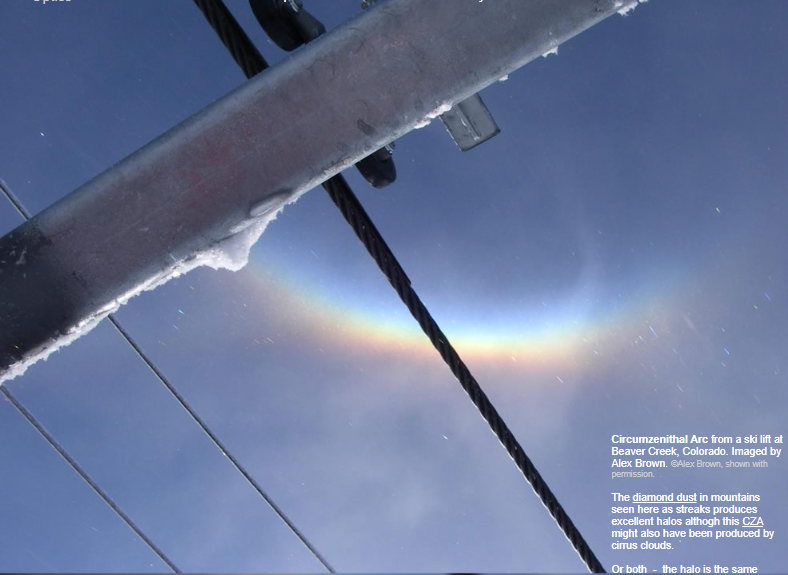Colorado CZA
Colorado CZA: Exploring the Spectacular Atmospheric Optics Phenomenon
Have you ever gazed up at the sky and been captivated by the breathtaking beauty of atmospheric optics? One particular phenomenon that never fails to amaze is the Circumzenithal Arc (CZA). This dazzling display of nature's artistry can be observed in various locations around the world, including the stunning landscapes of Colorado. In this article, we delve into the intricacies of the Colorado CZA, shedding light on its formation, appearance, and the awe-inspiring experience it offers to those fortunate enough to witness it.
The Colorado CZA owes its existence to a combination of factors, primarily the presence of diamond dust and cirrus clouds. Diamond dust refers to tiny ice crystals suspended in the air, which create a sparkling effect when sunlight interacts with them. These crystals are commonly found in mountainous regions and can produce exceptional halos. While it is challenging to differentiate between the effects of diamond dust and cirrus clouds in generating a CZA, their contribution to this phenomenon cannot be understated.
One fascinating aspect of the CZA is that its shape and angular size remain constant, regardless of the distance of the ice crystals. Whether they are near or far, the resulting halo retains its characteristic form. To identify the presence of diamond dust in images, one can look for their speckled appearance or observe their ever-shifting flashes of light, which add an ethereal quality to the scene.
As you gaze up at the Colorado sky in search of the CZA, keep a keen eye out for a subtle yet remarkable feature known as the supralateral arc. This secondary arc, which appears above the primary CZA, is often faint and requires careful observation to detect. Its presence adds an extra layer of intrigue to the already mesmerizing display.
Capturing the magnificence of the Colorado CZA through photography is a popular pursuit among enthusiasts. The unique combination of the majestic mountains, diamond dust, and cirrus clouds provides a picturesque backdrop for photographers to immortalize this natural wonder. If you find yourself lucky enough to witness the CZA firsthand, make sure to have your camera ready to capture the moment and share it with others.
The Colorado CZA is not limited to specific seasons or weather conditions. It can manifest itself at any time of the year, depending on the presence of the necessary atmospheric elements. However, certain weather conditions, such as cold temperatures and clear skies, are more conducive to its formation. Therefore, keeping an eye on weather forecasts can increase your chances of witnessing this awe-inspiring phenomenon.
To fully appreciate the Colorado CZA, it is essential to understand its scientific principles. The bending and reflection of sunlight by ice crystals in the atmosphere play a crucial role in creating the halo effect. As light passes through these crystals, it undergoes refraction and dispersion, resulting in the stunning display of colors that adorn the CZA. The precise alignment of the ice crystals determines the shape and position of the halo, making each occurrence a unique masterpiece.
In conclusion, the Colorado CZA is a breathtaking spectacle that showcases the wonders of atmospheric optics. Its formation through the interplay of diamond dust and cirrus clouds creates a mesmerizing halo in the sky. Whether you are an avid photographer or simply an admirer of nature's marvels, witnessing the Colorado CZA is an experience that will leave you in awe. So, next time you find yourself in the mountains of Colorado, remember to look up and be prepared to be enchanted by this extraordinary display of natural beauty.

Circumzenithal Arc from a ski lift at Beaver Creek, Colorado. Imaged by Alex Brown. ©Alex Brown, shown with permission.
The diamond dust in mountains seen here as streaks produces excellent halos althogh this CZA might also have been produced by cirrus clouds.
Or both - the halo is the same shape and angular size regardless of the distance of the crystals. We can often recogonise those from nearby diamond dust in images from their speckled appearance and live by their shifting flashes of light.
Look hard to see a trace of a supralateral arc.
Note: this article has been automatically converted from the old site and may not appear as intended. You can find the original article here.
Reference Atmospheric Optics
If you use any of the definitions, information, or data presented on Atmospheric Optics, please copy the link or reference below to properly credit us as the reference source. Thank you!
-
<a href="https://atoptics.co.uk/blog/colorado-cza/">Colorado CZA</a>
-
"Colorado CZA". Atmospheric Optics. Accessed on April 25, 2024. https://atoptics.co.uk/blog/colorado-cza/.
-
"Colorado CZA". Atmospheric Optics, https://atoptics.co.uk/blog/colorado-cza/. Accessed 25 April, 2024
-
Colorado CZA. Atmospheric Optics. Retrieved from https://atoptics.co.uk/blog/colorado-cza/.